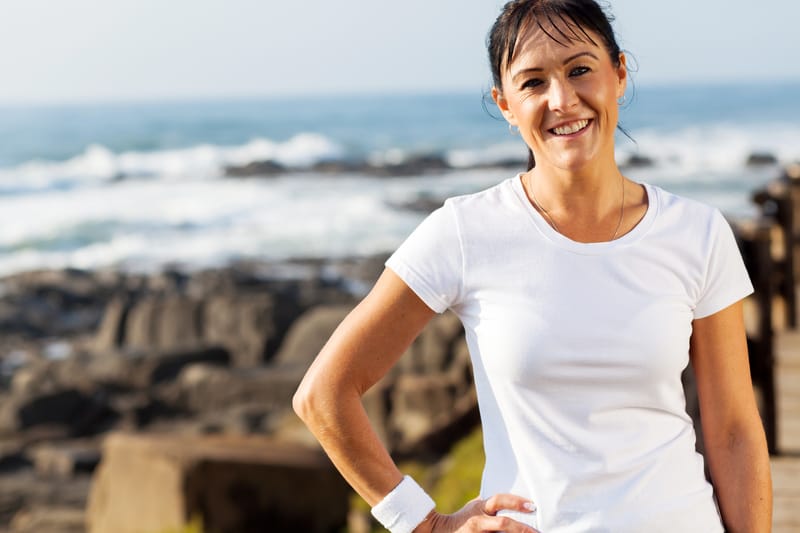Growing up, I used to wonder why my bust was small while those of my friends were large. I almost had my breasts enlarged through surgery. Much later, I learned about estrogen and discovered that it was very much responsible for the size of my breasts. The most interesting part of my discovery was that I could increase my estrogen level by stimulating the acupressure points to increase estrogen.
This meant that I could increase the size of my bust. Estrogen is not all about breast enlargement, however. It is a sex hormone in females that is responsible for the growth of breasts and pubic hairs, the start of menstruation, and childbearing. Estrogen is also responsible for keeping cholesterol in control, protecting the bones, and regulating moods.
You won’t enjoy these benefits of estrogen if your estrogen level is low. Low estrogen level is mostly the reason for less frequent menstrual periods, hot flashes, low sexual urge, mood swings, and dry skin. Women who mostly experience low levels of estrogen are those in menopause or those who have removed their ovaries through surgery.
The popular way to increase your estrogen level is through hormone therapy. However, research from the American Cancer Society reveals that long-term use of hormone therapy could lead to cancer. A safer way of increasing your estrogen level is through acupressure, and in this article, I’ll show you the right pressure points to stimulate to increase your estrogen levels.
Can Acupuncture Increase Estrogen Levels?

Acupuncture is an effective therapy for increasing estrogen. It helps regulate the disturbance of the autonomic nerve. The autonomic nerve helps in the secretion of female hormones. Acupuncture loosens the stiffness of this nerve. Also, acupuncture promotes lymph and blood flow, making it easier for secreted hormones and nutrients to be distributed to the bust.
Some studies support the use of acupuncture to increase estrogen. One of these studies reviewed acupuncture articles that analyzed sex hormones. It concluded that acupuncture changes sex hormone levels in several gynecological conditions in women such as menopause and ovarian dysfunction. The study proved that acupuncture increases estrogen, especially estradiol, progesterone, and prolactin.
Another study looked at the role of natural compounds and acupuncture in treating diseases caused by estrogen deficiency. The study concluded that acupuncture relieves symptoms of diseases caused by low estrogen without any side effects. However, certain natural compounds were found to complicate estrogen-dependent diseases.
Normally, estrogen secretion during a female’s lifetime is fixed and cannot be later increased. But when your estrogen secretion is low, it affects your ovary and hypothalamus, the part of the brain that commands estrogen secretion. This is the condition that then warrants you to seek acupuncture for estrogen increase.
The Pressure Points To Increase Estrogen
There are many acupressure points to increase estrogen in females. These acupoints aid the secretion of female hormones and blood flow. Stimulating them removes the element that causes a decrease in estrogen secretion and returns secretion to the original amount.
Below, we discuss nine (9) of these pressure points.
Acupoint: Ren-17 (Other Names: The Conception Vessel-17/Shan Zhong/Middle of the Chest)

Ren-17 is one of the notable acupoints to stimulate when you want to use acupuncture to increase estrogen. It is called Tanzhong in Chinese, and it is located in the chest. You’ll find it at the midline of the chest, mostly on the same horizontal line as both nipples.
In Traditional Chinese Medicine (TCM), Ren-17 is responsible for opening the chest, subduing rebellious lung Qi, and benefitting the breast. It activates the secretion of estrogen, thus relieving stress by adjusting the autonomic nerves.
It is for this reason that Ren-17 is used to treat asthma, cardiac pain, insufficient lactation, and palpitations. Ren-17 is also one of the calming pressure points on babies that mothers need to know.
Acupoint: SP-18 (Other Names: Spleen-18/Tian Xi/Celestial Cleft)
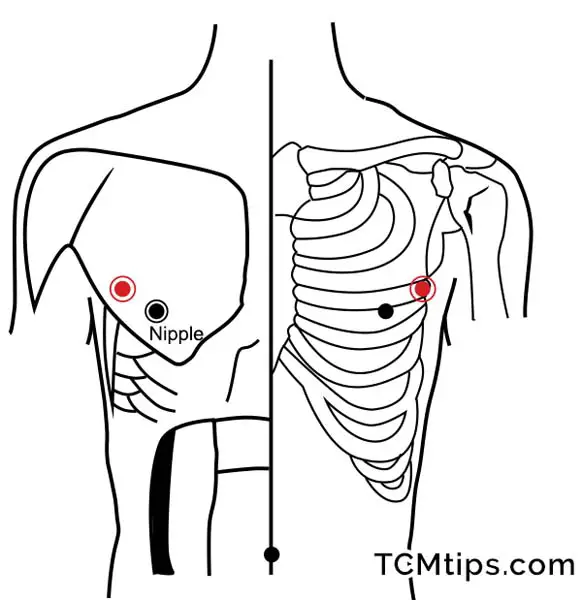
SP-18 or Tianxi, as it is called in Chinese, is another of the acupuncture points to increase estrogen levels in women. It’s also located in the chest, in the 4th intercostal space (which is the space between each rib) just like Ren-17. However, it is on the border between the chest and the flank, rather than on the middle of the chest.
Tianxi functions as a regulator of the chest and promoter of lactation. This is why it is used in the treatment of pains in the chest, cough, and insufficient lactation. You can also use SP-18 as one of the acupressure points for better breathing.
To unlock these benefits of Tianxi, massage the acupoint with your thumb in a circular motion before retiring to your bed.
Acupoint: KD-23 (Other Names: Kidney-23/Shen Feng/Spirit Manor)
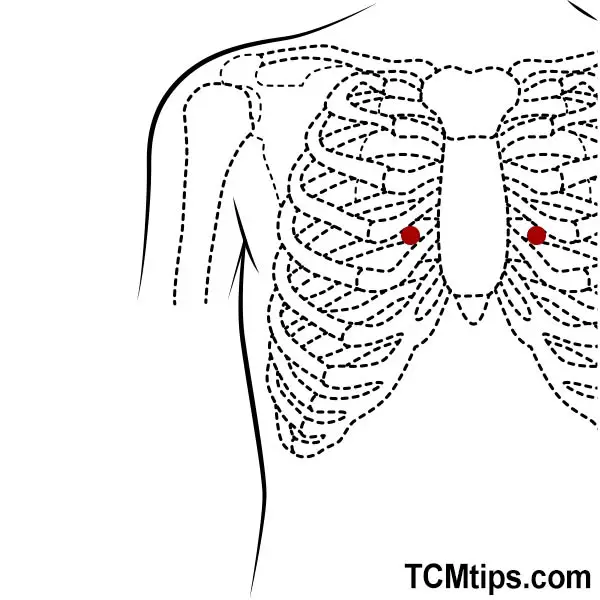
The next acupoint for acupuncture to increase estrogen is KD-23. This kidney meridian pressure point is called Shenfeng in Chinese, and it is also located in the chest. To locate KD-23, trace a finger to the 4th intercostal space, then measure two-finger width from the midline of the chest to the point in the 4th intercostal space. That point is KD-23.
KD-23 is responsible for opening the chest, bringing down rebellious lung and stomach Qi, and stopping cough. Therefore, it is used clinically to treat cough, nodules in the breast, and hypochondrium.
Acupoint: ST-15 (Other Names: Stomach-15/Wu Yi/Hiding the Breath)

ST-15, Wuyi, or Roof is a stomach meridian acupoint that is effective in increasing estrogen in females. It is also located on the chest, in the 2nd intercostal space, three-finger width from the midline of the chest.
In Chinese medicine, Wuyi supports the secretion of estrogen by improving the circulation of blood in the body. As hormone secretion is done by the ovaries in the pelvis, stimulating Wuyi promotes blood flow around the pelvis.
Clinically, ST-15 is used to treat infertility, irregular menstruation, asthma, cough, and acute mastitis.
Acupoint: Ren-12 (Other Names: The Conception Vessel-12/Zhong Wan/Middle Epigastrium)

Another pressure point for acupuncture to increase estrogen is Ren-12. This pressure point is called Zhongwan in Chinese, and it is located in the stomach, unlike the other acupoints discussed above. You’ll find Ren-12 by placing four fingers side-by-side above the navel.
In TCM, Ren-12 is responsible for harmonizing the spleen and stomach and resolving dampness. Thus, in addition to increasing estrogen levels, Ren-12 is used to treat epigastric pain, abdominal distention, acid regurgitation, and cough. Also, like Ren-17, Ren-12 is one of the calming pressure points on babies.
Acupoint: Bl-32 (Other Names: Urinary Bladder-32/Ci Liao/Second Crevice)

The bladder meridian acupoint, Bl-32, is the next acupoint for increasing estrogen in menopausal women. It is located on the lower back, midway between the dimples above the buttocks and lumbar spine.
In TCM, Bl-32 is considered as the pressure point that increases blood flow in the pelvis. It reduces coldness in the pelvis, thus increasing the secretion of estrogen. These functions of Bl-32 make it effective in the treatment of menstrual pain, irregular menstruation, and skin issues. It is also one of the effective acupressure points to start labor.
To activate the healing benefits of Bl-32 and the other pressure points discussed, exhale when you press the acupoint and inhale when you release your finger. It is best if you massage these acupoints when taking your bath or before retiring to bed. Desist from massaging these acupoints when you’re tired, ill, or pregnant.
Acupoint: SP-6 (Other Names: Spleen-6/San Yin Jiao/Three Yin Intersection)
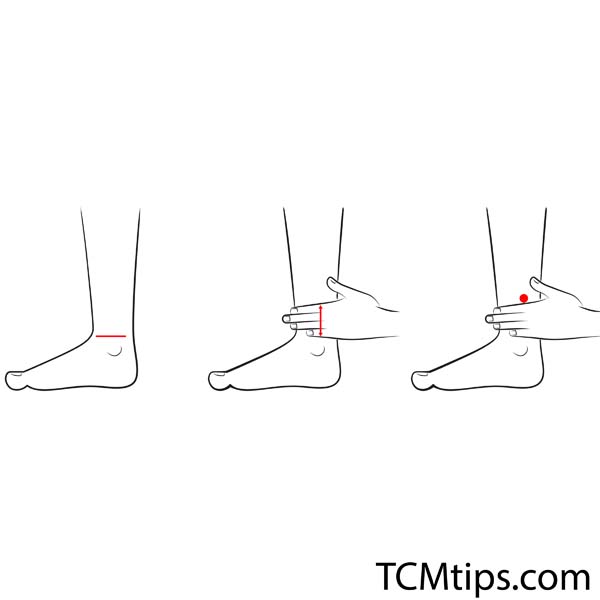
SP-6, Sanyinjiao, or Three Yin Intersection is another of the acupuncture points to increase estrogen. This spleen meridian acupoint is located in the leg. To locate SP-6, place four fingers side-by-side above the rise of your ankle. The point where the index finger rests is SP-6.
In TCM, SP-6 is a versatile acupoint. It is responsible for strengthening the spleen and stomach as well as the liver. It is also responsible for regulating menstruation and cooling the blood. Therefore SP-6 is used clinically to treat irregular menstruation, premature ejaculation, diarrhea, muscular pain, and several skin diseases. In winter, SP-6 is one of the pressure points to increase blood circulation in the feet.
When you stimulate SP-6, you prevent yourself from menopausal symptoms as well as obesity which can likely occur in women as a result of reduced estrogen.
Acupoint: KI-1 (Other Names: Kidney-1/Yong Quan/Gushing Spring)
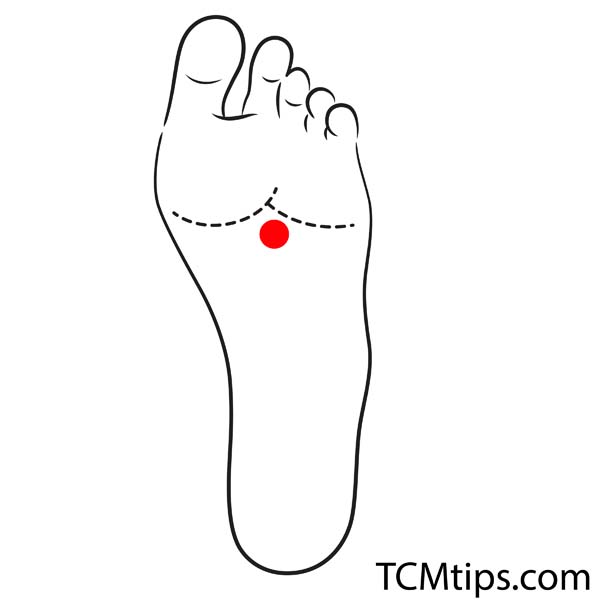
The next acupoint for increasing estrogen is KI-1. KI-1 is called Yongquan in Chinese, and it is a kidney meridian pressure point located in the foot. It is located in the depression between the second and third toes, one-third of the way down your foot when you scrunch your toes.
Yongquan is responsible for clearing heat, calming the Shen, and tonifying the Yin. For this reason, it is used clinically to revive consciousness, relieve headaches and pains in the neck, and stop dizziness and manic psychosis.
Are you looking for the pressure points to increase energy naturally? KI-1 is one of them.
Acupoint: SP-10 (Other Names: Spleen-10/Xue Hai/Sea of Blood)

SP-10, Xuehai, or Sea of Blood is another of the versatile acupuncture points to increase estrogen. This spleen meridian acupoint is located on the upper leg. To locate SP-10, bend your knees so that it is ninety degrees, then place three fingers above your knee cap. The point above your knee where the third finger rests is SP-10.
In TCM, SP-10 is one of the acupressure points in the leg that is responsible for treating all disorders relating to the blood. It moves, strengthens, and cools the blood. In addition to this, SP-10 packs a lot of benefits to this skin. This, in addition to increasing estrogen, SP-10 is used to treat irregular menstruation, blood stasis, eczema, and urticaria.
 P. Sze
P. Sze 